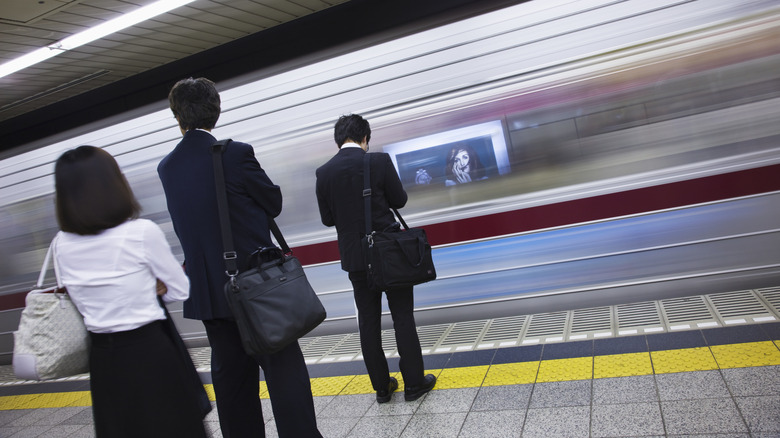The Unexpected Sounds Tourists Should Listen For At Train Stations In Japan
When you're in the train station in Japan, there's so much noise going in the background sometimes that it would be easy to tune it out altogether. This is especially true if you don't speak Japanese and can't understand the station announcements. If you listen closely on the platform, however, you might catch an unexpected snippet of a familiar tune in some stations as the train arrives or departs. Every station has its own unique jingle, and some of them are based on popular songs associated with a given place.
Perhaps the most instantly recognizable example of this would be the two jingles that play just outside the Tokyo city limits in Maihama Station. This stop on the Keiyō Line services the world's two best-rated Disney parks. Depending on which direction you're headed, you could either hear the theme from the "It's a Small World" boat ride or another famous Disney song, "Zip-A-Dee-Doo-Dah."
The latter is known for the repeated line, "Mister Bluebird's on my shoulder," and you might feel that way in Japan's train stations as you hear what sounds like a computerized bird chirping. This is another facet of the recurring white noise on station platforms that would be easy to miss if you're not paying attention. Birdsong can be used to assist the visually impaired in locating the escalator or ticket gate. It's like an auditory version of tactile paving, the thick yellow lines with bumps that help steer people away from the platform edge.
Well-known station jingles in Tokyo
In Tokyo, the Keiō Line (not to be confused with the aforementioned Keiyō Line) lets out near the skyscraper district west of Shinjuku Station, which holds the Guinness World Record for "busiest railway station." If you're riding away from the city, out into the suburbs, you'll eventually reach a station where you hear the opening bars of the hit John Denver song, "Take Me Home, Country Roads." This is your cue that you've arrived in Seiseki-Sakuragaoka Station, which inspired the animation in "Whisper of the Heart," the Studio Ghibli movie that helped popularize the song in Japan.
The JR Yamanote Line — perhaps the best way to get around Tokyo — loops around through the capital's other major city centers. One stop (Takadanobaba) is the home of Osamu Tezuka's "Astro Boy," one of the first anime broadcast on Japanese television. In the station, you'll hear the chorus of the show's theme song.
Though it might be more appreciated by cinephiles and fans of '50s pop, Ebisu Station's jingle is based on the theme song from the classic film noir, "The Third Man," starring Orson Welles. The song has appeared in commercials for the Yebisu beer brand, which has a brewery you can visit near the station. On the Chūō-Sōbu Line, Kōenji Station rocks dance tunes from the Awa Odori Festival every August. Before the Shiki ("Four Seasons") Theater closed, you could also hear Vivaldi's "Four Seasons" playing in Ōimachi Station on the Rinkai Line.
The wider world of departure melodies in Japan
In cities like Kyoto and Osaka, you'll hear station chimes that tap into the distinct character of each place, playing melodies that are evocative of traditional Japanese culture or popular regional songs. These familiar melodies act as a gateway to the unsung art of station jingles, leveraging the power of music as the universal language to help passengers connect with places. However, most departure melodies (called hassha merodii in Japanese) only last seven seconds. When you hear a music-box rendition that short, it can be like playing "Name That Tune."
Interestingly, there are some Tokyo subway lines, such as the Tōzai Line, where each seven-second melody acts as a link in a music chain. One by one, they will let you hear new pieces of the same song. These are the work of Minoru Mukaiya, the composer behind about 200 original melodies in over 110 Japanese train stations. Some commuters might hear Mukaiya's songs every day and be able to hum them without ever knowing their titles.
In a Japanese city, tourists should look to the ground, if only to see the designer manhole covers that are right under their feet. Look up in the station instead of down, and you might catch the similarly overlooked detail of a departure melody playing overhead. It could give you a new appreciation for where you're at when you consider someone went to all the trouble of creating a custom melody for this place.
